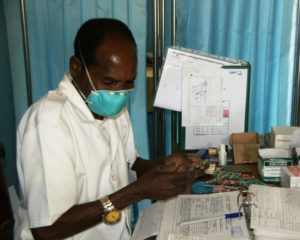 Successfully combating the tuberculosis (TB) epidemic requires that national TB programs (NTPs) prevent new infections and ensure that current patients are cured. Although the treatment for drug-sensitive TB is very effective, curing the disease requires that patients adhere to a strict daily regimen of multiple pills for six to nine months. Adding to the challenge is the fact that treatment for drug-resistant TB is longer, more toxic, and less effective. All medicines carry some risk of adverse events, and anti-TB medicines are no exception. In addition to threatening the health of patients, adverse events, if not well managed, may also result in individuals stopping their treatment early. Patients who prematurely discontinue treatment may remain sick, develop resistance to the medicines, and spread TB to others in their community.
Successfully combating the tuberculosis (TB) epidemic requires that national TB programs (NTPs) prevent new infections and ensure that current patients are cured. Although the treatment for drug-sensitive TB is very effective, curing the disease requires that patients adhere to a strict daily regimen of multiple pills for six to nine months. Adding to the challenge is the fact that treatment for drug-resistant TB is longer, more toxic, and less effective. All medicines carry some risk of adverse events, and anti-TB medicines are no exception. In addition to threatening the health of patients, adverse events, if not well managed, may also result in individuals stopping their treatment early. Patients who prematurely discontinue treatment may remain sick, develop resistance to the medicines, and spread TB to others in their community.
To support NTPs and health professionals to meet treatment goals and improve the safety of anti-TB medicines, the United States Agency for International Development (USAID)-funded Systems for Improved Access to Pharmaceuticals and Services (SIAPS) Program developed the first guide of its kind on minimizing risks associated with anti-TB medicines. Preventing and Minimizing Risks Associated with Antituberculosis Medicines to Improve Patient Safety outlines the process of planning and introducing risk-reduction strategies. This guide compliments WHO’s Practical handbook on the pharmacovigilance of medicines used in the treatment of tuberculosis: enhancing the safety of TB patients by providing in-depth information to identify and analyze the risks of TB medicines, prioritize solutions, and monitor outcomes.
Highlights of the USAID/SIAPS guide:
- Medicine risk reduction begins with identifying challenges that can prevent individuals from successfully completing their treatment. At this stage, NTPs must answer questions such as, “What can happen to a patient on this medicine?” and “At what point will this happen?”, keeping in mind that patients may also be taking medicines for HIV, diabetes, or other conditions.
- Once risks have been identified, the guide provides instructions on how to analyze risks by categorizing them according to factors, such as the likelihood of occurrence of each risk in relation to the estimated number of people that will be affected, and developing a scale to rank results according to their relative importance.
- From this ranking, NTPs can prioritize risks and develop plans to overcome them. Solutions include interventions, such as SMS messages to remind patients about how to take their medicines safely, and creating information guides for health care providers on topics, such as medicine safety for patients with both TB and HIV.
- Finally, monitoring and evaluation plans allow NTP staff to know if the intervention worked and to use the data to inform future improvements in medicines safety.
Living with TB is hard enough; providers and patients should have the information and resources necessary to make treatment as safe as possible. Although less toxic and shorter anti-TB regimens are desperately needed, opportunities to improve the existing process should not be ignored. Preventing and Minimizing Risks Associated with Antituberculosis Medicines to Improve Patient Safety is an important tool that can help NTPs and health professionals better manage risks and to ensure better health outcomes for patients.

